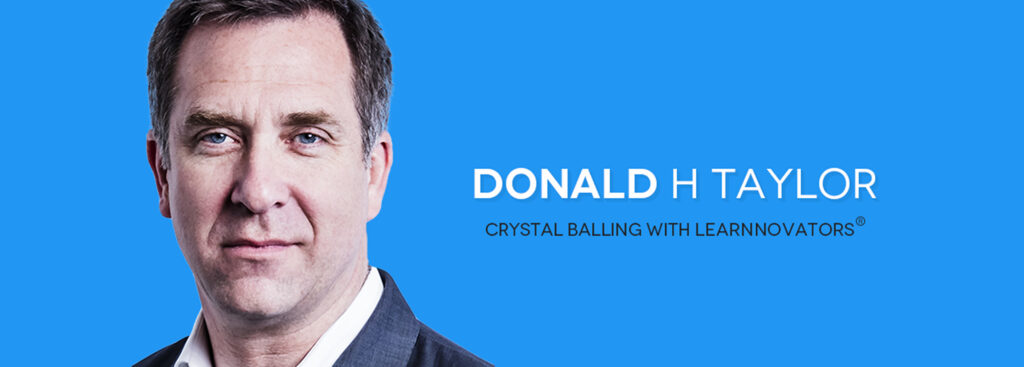ABOUT DONALD H TAYLOR:
Donald H Taylor is a 30-year veteran of the learning, skills and human capital industries, with experience at every level from design and delivery to being chairman of the board. He has been chairman of The Learning and Performance Institute since 2010.
A recognised commentator and organiser in the fields of workplace learning and learning technologies, Donald is passionately committed to helping develop the learning and development profession.
His background ranges from training delivery to director and vice-president positions in software companies. Donald has been a company director and shareholder for three companies through start up, growth and acquisition.
In 2017, Donald was appointed as a non-executive director to London-based learning technology start up Filtered, which uses patented algorithms to make intelligent learning recommendations.
He is an influential writer and speaker in the fields of the professional development of L&D and of technology-supported learning. He was the 2007 recipient of the Colin Corder Award for services to training and has chaired the Learning Technologies Conference since 2000.
ABOUT THIS INTERVIEW SERIES:
Crystal Balling with Learnnovators is a thought-provoking interview series that attempts to gaze into the future of e-learning. It comprises stimulating discussions with industry experts and product evangelists on emerging trends in the learning landscape.
Join us on this exciting journey as we engage with thought leaders and learning innovators to see what the future of our industry looks like.
THE INTERVIEW:
1. LEARNNOVATORS: In this age of business digitalization, we believe that the very first step for companies to be successful is to have the right learning vision, and a learning culture that aligns with the identified vision. At the same time, we realize that ensuring this is a real challenge facing many companies today. What role do you think learning leaders can play in thought-partnering with senior management in forming the right learning vision, and shaping the desired learning culture?
DONALD H TAYLOR: If learning leaders are to have any impact on learning culture and vision, they have to work with the top of the organization, but it is the senior management and executives who make or break these efforts. My advice to anyone in an organization that refuses to evolve and support a digital learning culture is to look for work elsewhere. Not only can’t you advance yourself in such an organization, it is likely to fail in the future.
2. LEARNNOVATORS: As we see, technological innovations such as artificial intelligence (with its ‘arsenals’ such as machine learning and deep learning) and robotics are all set to disrupt industries across the world. What does the modern learning / talent development landscape look like in the age of intelligent machines? What kind of up-skilling or re-skilling is required for today’s workers to be safe in their jobs? How is L&D going about addressing this challenge? What strategies would you suggest for L&D-ers to up-skill themselves to stay relevant?
DONALD H TAYLOR: This is a huge question. It would be tempting to say that L&D professionals should get skilled up in AI, but I wouldn’t suggest this. It’s a deep, complex field and it makes more sense to recruit specialists with AI skills, or partner with them, or work with the increasing range of AI tools for L&D. Rather than the answer lying in the skill of implementing AI, I believe it lies in the knowledge of what to do with it. Be aware of what is possible with AI, understand it well enough to ask the specialists the right questions and to be able to tell when their answers make sense.
3. LEARNNOVATORS: We had the opportunity to try out ‘Magpie for L&D’, and were amazed at the kind of intelligent learning recommendations offered by its powerful algorithm. As the Non-Executive Director of Filtered.com (the AI start up behind the platform), how do you think Magpie can help L&D in making their training strategies more effective? What, according to you, is the future for such AI powered tools that assist L&D in improving the productivity and proficiency of their workforce?
DONALD H TAYLOR: Magpie is an AI tool that can amplify the effectiveness of a learning and development team. Often a focused L&D initiative will have a significant impact on skills and productivity, but for a limited group of learners or for a short duration. Resources and cost pressures prevent a wider or more consistent rollout. Magpie can take that L&D initiative – of content selection, curation, needs analysis and/or prioritisation – and embody it in algorithms. Then it can be scaled economically.
Importantly, I also see L&D teams using the data that Magpie generates, whether that’s understanding the training content that is most in demand, or what has most impact, or finding where people feel gaps in their capability are holding them back. Increasingly in the future, L&D that are data savvy will be the ones able to make the most impact.
In the future, AI will enable L&D to stay with the learner much more consistently as they apply learning in the flow of work. Because AI can cope with unstructured and voluminous data, it will start to use the data generated in workflow apps – like Slack, Microsoft Teams, Google Drive, email clients – and provide performance support and identify longer term development needs based on a 360 degree, 24-7 view of the learner. This will mean L&D can play a more central role in organisational strategy and delivery.
4. LEARNNOVATORS: The L&D Capability Map is a great collection of skills, ranked by levels, which describe the abilities needed of the modern L&D department. As Chairman of The Learning and Performance Institute (LPI) which you have been chairing for over 12 years now, what is your vision behind this social initiative? What were some of the challenges you faced in bringing out this framework? How do you visualize this platform serving the role of a ‘common language’ for L&D to provide better support for learning and performance in today’s workplaces? What kind of discussions has the revised version (2018) kick-started in the community? Can you share your views on these for our readers please?
DONALD H TAYLOR: Of the many things I’ve been part of in L&D over 30 years, the LPI Capability Map is what I’m proudest of. The LPI aims to make this the international language of competency for L&D, underpinned by three things. First, the Map was not dreamed up by a small committee sitting in a room; it was created out of input from expert practitioners, across the globe. Second, we are committed to keeping the Map free for individual use, via our online platform, to help them understand how to develop themselves professionally, wherever they may be in the world. Finally, we will continually be adding to the value of the Map, making it increasingly useful over time.
5. LEARNNOVATORS: To quote Jay Cross from our interview with him, “Learning & development professionals often push what they can control. The informal realm is scary because it empowers the learner. That’s a loss of control for training departments and it makes them uncomfortable”. He further adds that “…informal learning doesn’t show up on the corporate radar because it isn’t recorded in industrial-age charts of account”. What would be your advice to the L&D folks on extending informal learning into the workflow? From your experience, how are today’s forward-thinking organizations faring in blending informal and social learning with their traditional formal learning programs?
DONALD H TAYLOR: It’s not possible to ‘extend informal learning into workflow’ because it’s already there. People are already learning from experience and from each other, every hour of every day. The problem L&D has today is trying to find ways to optimize and support learning, whereas in the past it has been focused on producing content. If we shift the focus from content to learning, then the question of blending formal and informal goes away. We’re just talking about learning, not about content types or delivery mechanisms. The question then becomes, how do we help people learn better – from providing the right environment, to engaging managers, to ensuring relevance.
6. LEARNNOVATORS: Some forward-thinking organizations are already re-designing their employee recruitment processes around ‘learning agility’ over academic qualifications (grades/points). However, not many companies seem to be following suit. What kind of shift in thinking would you recommend for companies to get transformed into a forward-thinking organization in this regard? What would be L&D’s role in this transformation?
DONALD H TAYLOR: L&D exists to help organizations and individuals fulfill their potential. The route to that will vary, company by company; so I would certainly not advise any organization to try to copy what another has done. Rather, I would start by engaging the executive team and senior management around their concerns for the short, medium and long term. The business aims should be the starting point for setting L&D transformation, not how it organizes its own delivery.
7. LEARNNOVATORS: Your book “Learning Technologies In The Workplace” offers brilliant insights, based on your vast experience, on the techniques for ensuring successful learning technology implementations in today’s workplaces. What prompted you to write it? And, if you were to give our readers one key take-away from the book, what would that be?
DONALD H TAYLOR: I wrote the book because I saw people repeating the same mistakes in implementing learning technologies that I’d seen a decade or more previously. So I looked at what successful implementation teams did, and summarized it in the book. If you wanted me to boil that down to a single take-away, it would be a quote from Andy Wooler: “You can do everything with technology. But people can stop you doing just about anything.” In other words, for a successful implementation, start with the people. Always.
8. LEARNNOVATORS: You have been serving as Chairman of the Learning Technologies Conference – Europe’s largest conference dedicated to workplace learning – for the past 19 years. What have been your takeaways with respect to the challenges L&D practitioners face, based on your interactions with them? What would workplace learning look like in 2019 and beyond? What would be the trends and challenges?
DONALD H TAYLOR: I have two takeaways. The first: very little changes in L&D over time. We face the same challenges of providing value and changing lives. The second: everything has changed. We’ve moved from an era when knowledge was power to one where information is almost free and frictionless. The role of L&D is no longer to provide information, but rather to inspire and support learning. The challenge to our profession is whether we can wean ourselves off our addiction to content and focus on what really needs to be done – helping people learn.
9. LEARNNOVATORS: Hearty congratulations on being awarded the ‘Honorary Doctorate’ by Middlesex University in recognition of your work in professionalising the learning and development industry. It is inspiring to note that you had the honor of being awarded the Colin Corder Award way back in 2007 for your substantial contribution to the training profession. How do you look at these achievements? And, how do you think these recognitions will help fuel your vision for the learning community?
DONALD H TAYLOR: It is always an honour to be recognized for one’s achievements, but I see awards as a spur to further work in the work. They demand more work, at a higher level. When I’m 70 I want to be able to look back not at any awards I may have garnered, but at how useful I have been. If I can say that I have advanced the L&D community, and been useful and charitable in doing so, then I will be happy.
LEARNNOVATORS: Thank you so much for sharing your valuable insights and experiences, Donald. It was wonderful interacting with you. We wish you the very best!






